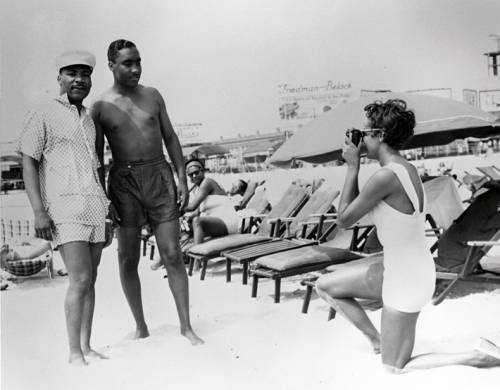[Dr. Martin Luther King Jr. on Chicken Bone Beach]
Item
-
Title
-
[Dr. Martin Luther King Jr. on Chicken Bone Beach]
-
Description
-
Civil rights leader Martin Luther King, Jr. and Rev. Russell A. Roberts posed for a snapshot while relaxing on segregated Chicken Bone Beach in Atlantic City, New Jersey.
-
According to Temple University Libraries, Charles L. Blockson Afro-American Collection: Chicken Bone Beach was the segregated section for African Americans on Atlantic City's beach area. Between 1900 and the early 1950s, African Americans were socially restricted to use the Missouri Avenue Beach Area. Since many vacationing Black families arrived with chicken-laden hampers, the strip became affectionately named Chicken Bone Beach.
This photograph is of Rev. Dr. Martin Luther King Jr. (January 15, 1929-April 4, 1968) with Rev. Russell A. Roberts (1923-February 11th, 1959) posing together in beachwear on Chicken Bone Beach in Atlantic City, NJ. Rev. Dr. King is looking straight at the camera, and Rev. Roberts is posing to the right at a kneeling female photographer. The two were friends and former seminarians (Rosenberg 2022). Joseph Louis Barrow (May 13, 1914-April 12, 1981), otherwise known as Joe “Brown Bomber” Louis, said to be featured to the left of Rev. Dr. King reclined in a beach chair (Rosenberg 2022).
Rev. Dr. Martin Luther King Jr. is internationally known and respected for his leadership of the American Civil Rights Movement, activism, religious teachings, and oratory skills (The King Center, n.d.). He is “widely regarded as America’s pre-eminent advocate of nonviolence and one of the greatest nonviolent leaders in world history” (The King Center, n.d.). Throughout his life, he spent time and made connections in the Philadelphia-area, including Atlantic City, NJ (Turner, n.d.). For instance, in June 1957, Rev. Roberts arranged for Dr. King to speak at the Atlantic City High School (Turner, n.d.).
Rev. Roberts was a respected pastor of Shiloh Baptist Church for 10 years on Ohio Avenue in Atlantic City, NJ (The Baltimore Afro-American 1959). He was perhaps most popularly known for intense praying and fasting for 11 days in support of the Montgomery, Alabama bus boycott in 1956 (Atlantic City Press 1955; Atlantic City Press 1959). He was “heralded as one of the greatest evangelists since Billy Sunday,” and traveled nationally drawing in large crowds over 10,000 people (Atlantic City Press 1955; Atlantic City Press 1959). Rev. Roberts was a native of Worchester, Massachusetts, and was well-educated having attended Livingston College, Hood Theological Seminary, and Hampton Institute (Atlantic City Press 1959). Rev. Roberts was formerly a prize fighter, and once sparred ex-world heavyweight champion Jersey Joe Walcott (The Baltimore Afro-American 1959).
Joe “Brown Bomber” Louis (to the left of Dr. King) is regarded as one of the greatest boxers and athletes of all time– his power and strength symbolic of the relentless resilience of African Americans, and American dominance more broadly (Rosenberg 2022; National Museum of African American History & Culture, n.d.). Malcolm X once said of his influence, “Every Negro boy who could walk wanted to be the next Brown Bomber” (National Museum of African American History & Culture, n.d.). He was respected by Presidents Franklin Roosevelt and Ronald Reagan (National Museum of African American History & Culture, n.d.).
The photo was taken at “Chicken Bone Beach” (also dubbed “Sunshine Row” by showgirls or simply “the place to be”) of which was famously popular and frequented by local and visiting families of all classes, celebrities, entertainers, and politicians in and of the Black community (Hart 2022; Stephens 2014; UMBC Interdisciplinary CoLab, n.d.). It was a place of fun, rest, resilience, pride, and leisure. It is said that fried chicken was eaten frequently and the leftover bones buried in the sand, hence the name “Chicken Bone Beach” (Hart 2022; Stephens 2014). The beach location, and other hot spots in the surrounding area at the time, can be viewed below, courtesy of University of Maryland, Baltimore County (see “Chicken Bone Beach”). From the early 1900s until the passing of the Civil Rights Act of 1964, the beachfront accessible from Missouri Avenue was the only space that African Americans were permitted to use due to segregation and the desire of resort/hotel owners to restrict African Americans from their beachfront properties (Hart 2022; Rosenberg 2022; Stephens 2014).
This photo is part of the John W. Mosley Collection at the Charles L. Blockson Afro-American Collection at Temple University Libraries, of which was acquired in the late 1980s from the Mosley family (Hart 2022). John W. Mosley (1907-1969) was a Philadelphia-area African American photographer who photographed many prominent figures, places, and culture between the segregation period of the 1930s to the Civil Rights Movement of the 1960s (Temple University Libraries). He moved to Philadelphia in 1934, and photographed frequently in Atlantic City, NJ amongst other areas in the region.
-
Chicken Bone Beach
-
Rights
-
This material is subject to copyright law and is made available for private study, scholarship, and research purposes only. For access to the original or a high resolution reproduction, and for permission to publish, please contact Temple University Libraries, the Charles L. Blockson Afro-American Collection (blockson@temple.edu; 215-204-6632).
-
Creator
-
Mosley, John W.
-
Format
-
Image
-
Spatial Coverage
-
Atlantic City, NJ
-
Publisher
-
Temple University Libraries, Charles L. Blockson Afro-American Collection
-
Contributor
-
Temple University Libraries, Charles L. Blockson Afro-American Collection
-
Identifier
-
BPA001X0319560000002
-
Date Created
-
(c. 1950's)
-
Is Part Of
-
John W. Mosley Photograph Collection
-
Subject
-
Beaches
-
Segregation
-
African American men
-
King, Martin Luther, Jr., 1929-1968
-
African American religious leaders
-
African American civic leaders
-
Atlantic City (N.J.)


